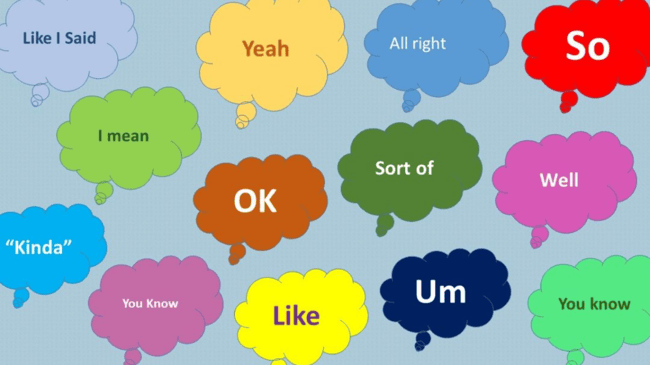What are Filler Words
Filler words or interjections are words that people use as placeholders during speech. They include: um, uh, like, you know, so, sort of, kind of, and ah.

These are all words and phrases that little or no meaning to what is being said. The range of fillers used across all populations of speakers goes from as little as 0.12% of words spoken to as much as 8.8%. Fillers not only make the speaker appear less knowledgeable, less confident, and less relatable to an audience, but also distract the audience from the content being delivered.
Why Do We Use Filler Words?
A person may use filler words in verbal communication for a variety of reasons:
- Sometimes it’s an expression of nervousness due to unfamiliarity with the subject content, the audience, or the setting.
- Sometimes it’s a speaker’s way of holding space while thinking about what to say next.
- Interestingly, studies have shown that men are more likely to use filler words than women.
While a certain amount of filler words is natural in verbal communication, and their use can make a person seem more genuine, it is important to strike a balance. Excessive use of fillers can be detrimental to effective communication. Learning how to stop saying um and other fillers involves techniques that we’ll cover further in the article. A person might sound unnatural if all filler words were eliminated; thus, the key is moderation rather than complete elimination.
How to Avoid Filler Words
Eliminating filler words in work conversations gives the impression of the speaker being more proficient in their field. In personal relationships, eliminating filler words makes the speaker appear more mature and confident. Just as there are a variety of reasons for using fillers in verbal communication, there are equally diverse strategies for how to get rid of filler words:
Know the Material
Lots of people struggle with communicating when they are not familiar with the content to be delivered. Take plenty of time researching the topic, and err on the side of having too much information, rather than not enough. Once research is complete, start writing the information in a tone appropriate for the setting. If the format is an interview, try to get the questions ahead of time or have friends and family conduct mock interviews so the answer flows off the tongue without having to think out loud (“uh…”). Take the time to write down the questions and study them. For a presentation that allows for questions, anticipate what others may want to know about the topic or think about questions that have been asked at previous presentations so that you’re well-prepared.
Rehearse
Practice makes perfect. Before giving a presentation in public for the first time, practice the entire presentation in front of the computer camera and share it with a trusted friend or colleague, or wait at least 24 hours to watch the video. This is better than practicing in the mirror because during the playback, you can take notes on undesirable behavior such as poor eye contact, use of filler words, stuttering, flat affect, mumbling, inconsistent volume, or confusing language. A presentation that is well-edited contributes to positive perceptions of the audience.
Build Vocabulary
A large arsenal of words will decrease the need for filler words, especially like and you know. Knowing exactly what to say and how to say it ensures the audience will understand the message the first time. Use vocabulary that is appropriate for the educational level of the audience. For words that may not be easily understood by all audiences, have a variety of synonyms available.
Focus
Sometimes a speaker will add filler words because he or she is daydreaming or thinking about what he or she is going to say. Improving focus in the moment will help avoid awkward moments such as silences, excessive use of filler words or forgetfulness. A speaker should make eye contact with the audience in order to keep them engaged and read their reactions. Remember: communication is a two-way street.
Relax
A common cause of using excessive filler words is being nervous. Get a good night's sleep the night before and eat a nutritionally balanced light meal an hour before speaking if possible. Take a few deep breaths before going on stage or getting behind the microphone.
Control the Clock
Especially in situations when the speaker is given a specific length of time, they may rush through the material out of fear of not saying everything they need to say, and ending up with excess time to fill. Instead of adding empty filler words or extended pauses between thoughts, try adding a joke, personal story, or other appropriate anecdote as the situation allows. Engaging the audience by asking questions and giving them a chance to speak is also an easy, low-stress way to avoid awkward fillers at the end of a presentation.
Take Feedback Seriously
Many times presenters at conferences or in clubs or classes are reviewed by the audience. When those reviews are made available, take them seriously and use them to improve for the next time. There is always room for improvement and the feedback you can get from your audiences is the best way to learn.
Final Words
Reducing filler words in speech enhances clarity and confidence in communication. It's a skill that, when mastered, benefits both professional and personal interactions. Continuous practice and awareness are key to achieving more impactful and persuasive speech.

.png?width=1900&name=blog_banner%20(1).png)
.jpg)
